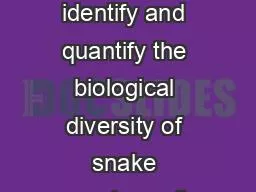

Copé region We added sequences from global databases to help confirm the identity of field samples and look for new ones We analyzed these sequences by inferring the phylogenetic trees of evolutionary relationships for various snake groups to help quantify the biodiversity of snakes in this reg ID: 785142
Download The PPT/PDF document "In this project we set out to identify a..." is the property of its rightful owner. Permission is granted to download and print the materials on this web site for personal, non-commercial use only, and to display it on your personal computer provided you do not modify the materials and that you retain all copyright notices contained in the materials. By downloading content from our website, you accept the terms of this agreement.
Slide1
In this project we set out to identify and quantify the biological diversity of snake samples collected in field expeditions conducted of Panama from 2008 to 2012 in the El
Copé
region. We added sequences from global databases to help confirm the identity of field samples and look for new ones. We analyzed these sequences by inferring the phylogenetic trees of evolutionary relationships for various snake groups to help quantify the biodiversity of snakes in this region of Panama. We also highlight the importance of DNA barcoding as a first step in any molecular study, because often field identification alone cannot confirm the identity of species, especially when samples are in poor condition.
Panama, though seemingly just a small country between North and South America, is in reality a very important place for tropical wildlife (Myers et al. 2000). Panama is a conservation hotspot, and therefore, we hope that with our research we can bring attention to the true diversity of Panama’s flora and fauna, and help come up with new ideas to protect species from existing problems (
Gagliardo et al. 2008). Rapid deforestation and diseases like the chytrid fungus also threaten species (Crawford et al. 2010). We also hope to prove that DNA barcoding is essential for proper identification of field samples, as it is often difficult to properly identify specimens based on physical attributes alone (Hebert et al. 2003).
Abstract
Introduction
Methods and Materials
Studying Snake Genetics in Panama, A Biodiversity Hotspot
JieJie Yuan
1 | Mendaka Bineth Abeysekera2 | Marcelo Gehara3 | Arianna Kuhn3,4
1: Student - Hunter College High School. 2: Student - Stuyvesant High School. 3: Mentor - American Museum of Natural History, Herpetology. 4: Mentor - City University of New York Graduate Center, Ecology Evolutionary Biology & Behavior.
We would like to thank the American Museum of Natural History for molecular laboratory support; Edward Myers, Sara Ruane, Julie Ray, & Frank
Burbrink
for tissues; the Urban Barcode Research Program for the opportunity; Cold Spring Harbor Laboratory for training us; Christine for her patience and assistance; Small Wonder for emotional support; Isaac Overcast for those one time flaming hot Doritos; and finally, to everyone in the Herpetology department, thank you for the eternal supply of Oreos and jokes and meme drawings.
Acknowledgements
Crawford AJ, Lips KR,
Bermingham
E (
2010) Epidemic disease decimates amphibian abundance, species diversity, and evolutionary history in the highlands of central Panama. Proc Natl Acad Sci USA, 107, 13777–13782.Gagliardo R, Crump P, Griffith E et al. (2008) The principles of rapid response for amphibian conservation, using the programmes in Panama as an example. International Zoo Yearbook, 42, 125–135.Hebert PD, Ratnasingham S, de Waard JR (2003) Barcoding animal life: cytochrome c oxidase subunit 1 divergences among closely related species. Proc Biol Sci, 270, S96–S99.Myers N, Mittermeier RA, Mittermeier CG, da Fonseca GA, Kent J (2000) Biodiversity hotspots for conservation priorities. Nature, 403, 853–858..
Literature Cited
El Cope National Park
Discussion
Several samples were misidentified in the field:
Our
sipos
snake samples (
Chironius
grandisquamis
)
were misidentified.
Both eyelash viper (
Bothriechis
)
samples were actually young vipers (
Bothrops
).Our A. veliferum samples were actually from a threatened species who shares several similar physical traits with A. veliferum, Urotheca fulviceps.Several samples may represent new snake populations:The misidentified Drymobius margaritiferus could be a new subspecies, due to the fact that adult milksnakes (Lampropeltis triangulum) and D. margaritiferus are very difficult to mix-up.Our genetic data for the Fer-de-Lance viper represents a previously undersampled population.Our parrotsnake specimens may represent a new species, or a hybrid due to the low genetic match with pre-existing L. ahaetulla.We confirmed the identity of several unknown samples:All of our samples labelled Dipsas sp. were D. temporalis.Our unknown sipos snake sample (Chironius sp.) was C. flavopictus. We conclude that it is important to properly document field specimens by barcoding, as taxonomic identification is often faulty and it is important to always barcode field data, especially in understudied regions.
Results
A.
Our
A.
veliferum samples (Rusty headed snake) were more closely related to Urotheca fulviceps or U. pachyura than real A. veliferum.
B.
Both of our eyelash viper samples (
B. schlegelii) turned out to be Bothrops asper due to physical similarities.
C.
Our samples of Fer-de-lance viper,
B. asper, appear to be paraphyletic, and they are related to Columbian Bothrops.
D.
While most of our D. margaritiferus samples were true, one was identified as L. triangulum, a distantly related milksnake.
E.
One of our parrot snakes,
L.
ahaetulla
, had an unusually low match of 92%. Our other specimens were closely related to L. depressirostris.
F. Though a few of our samples were identified correctly, other specimens like our Chironius grandisquamis actually turned out to be C. flavopictus.